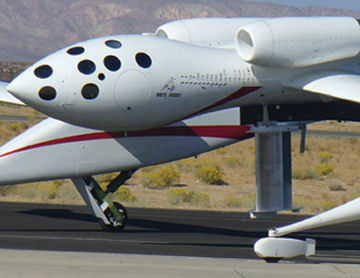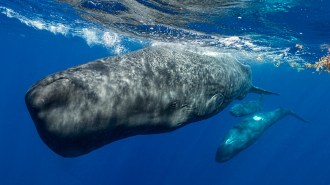Airplane designers have long admired how birds reshape their wings for soaring, diving, and maneuvering. Now, a prototype aircraft wing has demonstrated in its first flight tests that its morphing might save fuel.

In a series of evaluations that began in October and ended last week, subtle shape-shifting by the wing’s trailing edge minimized fuel-wasting air resistance, or drag, at a variety of altitudes, speeds, wing angles, and other conditions, says aeronautical engineer Russell F. Osborn Jr. of the Ann Arbor, Mich.–based company FlexSys, which created the wing.
“This is something that the aerospace community has been after for a long time,” says aerospace engineer Peter M. Flick of the Air Force Research Laboratory (AFRL) at Wright-Patterson Air Force Base near Dayton, Ohio, who heads the program that’s funding the wing’s development. In recent years, numerous research teams have been investigating ways to morph wings and other aircraft parts (SN: 12/6/03, p. 359: Wings of Change).
Aeronautical engineers had previously made military jets, such as the F-111, with wings that can change shape. However, heavy hinges and other ponderous hardware needed for that complex mechanism made the technology impractical.
The newly tested approach relies instead on a relatively lightweight, one-piece network of aluminum within the wing, says mechanical engineer Sridhar Kota of the University of Michigan in Ann Arbor and the president of FlexSys.
The metal construction flexes on command. Simple rods attached to motors impose forces in specific directions, to which the aluminum network complies readily. The wing responds by smoothly curving its trailing edge downward or upward.
At the same time, the network ruggedly resists deformation by wind. During wind tunnel tests last spring, Kota says, the prototype wing resisted aerodynamic forces more than three times as great as those expected in flight. “Dr. Kota’s accomplishment is beneath the [wing’s] skin,” comments flexible-wing specialist Terry A. Weisshaar of Purdue University in West Lafayette, Ind. “He has showed that the lightweight design is flightworthy.”
Donald Paul, chief scientist of AFRL’s Air Vehicles Directorate, says that the adaptability of the wing makes it a shoo-in for use in future generations of robotic military-spy planes that hover at high altitudes for long periods of time. Because such an aircraft loses a large fraction of its weight as it burns fuel, it undergoes major changes in its aerodynamic characteristics during a single flight. Morphing wings should enable such a vehicle to operate with minimal drag, and therefore minimal fuel use, across the full range of operating conditions, Kota says.
Other military and civilian aircraft, including large passenger jets, could also benefit. “You may be surprised where the technology shows up,” says Paul. Since the early flight-test data came in, aircraft makers Boeing, Lockheed, and Northrop-Grumman have all expressed interest, he adds.
In the recent tests, the wing was carried aloft by a jet known as the White Knight, which was used to launch the first manned, privately built vehicle to reach space (SN: 10/9/04, p. 228: Available to subscribers at Dawn of the commercial space age).
The morphing wing flexed its edge at heights of roughly 8,000 and 12,000 meters while sensors measured the novel wing’s aerodynamic performance.





